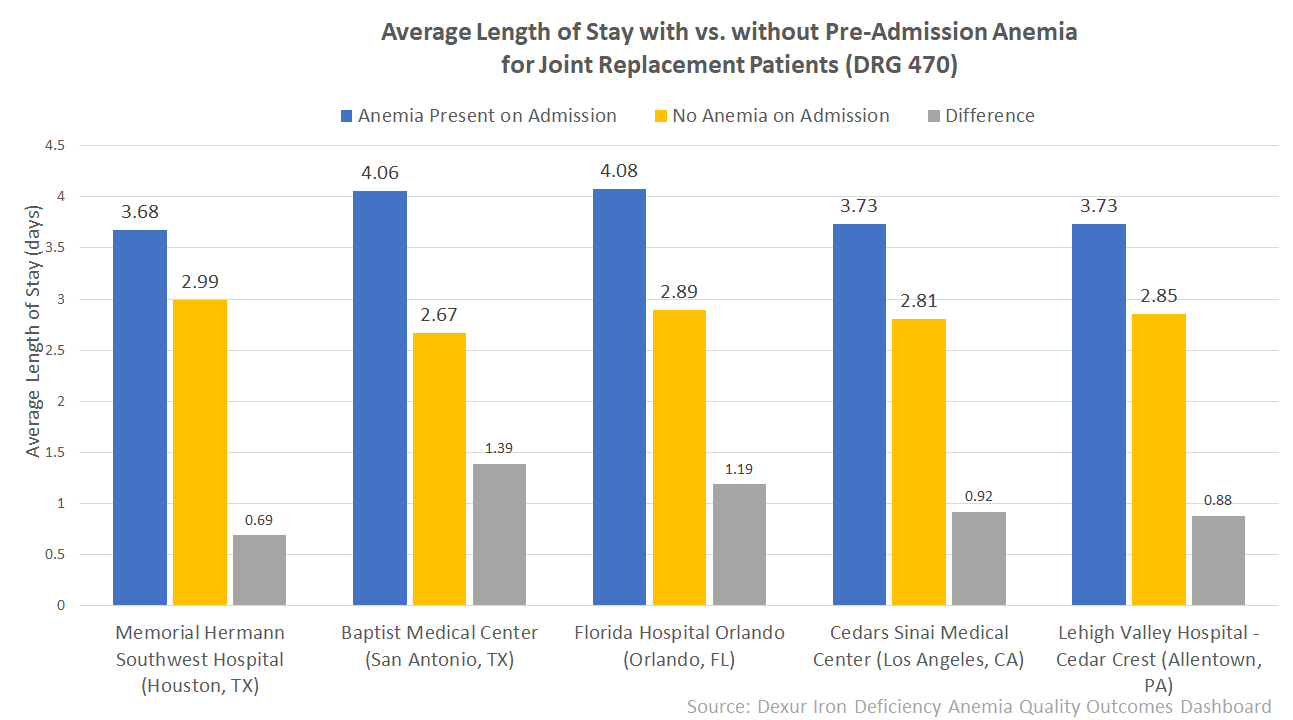Iron Deficiency Anemia is associated with a Longer Length of Stay for Hip & Knee Surgeries Based on a Five Hospital Study
In Iron Deficiency Anemia (IDA)
Get Dexur’s Personalized Hospital Specific Presentation on Quality, Safety, Compliance & Education
By: James Pitt May. 01, 2018
Iron deficiency anemia (IDA) is the most common nutritional deficiency worldwide. Symptoms include fatigue, weakness, and pale skin. Diet and gastrointestinal problems can cause IDA. But blood loss is more common. As the Merck Manual notes, “Iron deficiency is one of the most common causes of anemia, and blood loss is the most common cause of iron deficiency in adults.”
Joint replacement patients are at higher risk of death and complications if they have anemia before the procedure. Duke University’s Perioperative Enhancement Team recently published a guide for treating pre-operative anemia to improve outcomes and reduce costs. Patients who received iron supplements before major joint surgery were less likely to experience drops in hemoglobin than patients who received placebo. Anemia in joint replacement patients is well studied, with comprehensive reviews as early as 2010, by Dr. Donat Spahn in Anesthesiology. As Dr. Spahn details, “Preoperative anemia is a major risk factor for adverse outcome in major surgery.”
Dexur analysts examined length of stay (LOS) in Medicare-eligible inpatients with iron deficiency anemia at five major hospitals. The analysis was limited to Hip & Knee surgeries, specifically Major Joint Replacement or Reattachment of Lower Extremity Without Major Complication or Comorbidity (DRG 470). Length of stay is a good proxy for illness severity: sicker patients tend to stay in-hospital longer. It is one of the metrics the CMS Comprehensive Care for Joint Replacement initiative takes into account.

At all five hospitals, DRG 470 patients with IDA present on admission had substantially longer length of stay than those without IDA on admission. Therefore, treating anemia before admission may be an opportunity to improve care for total joint replacement patients.
Baptist Medical Center had the greatest LOS difference of 1.39 days, indicating patients with pre-admission anemia may be of special interest at this hospital. Memorial Hermann Southwest had the smallest LOS difference at .69 days. Florida Hospital Orlando, Cedars-Sinai, and Lehigh Valley Hospital Cedar Crest had intermediate LOS differences for patients with and without IDA.
DEXUR PRO MEMBERS GET ACCESS TO:
- Total discharge volume, iron deficiency anemia discharge volume, average length of stay for all, anemic, and non-anemic patients, and average difference in length of stay between anemic and non-anemic patients for Medicare-eligible inpatients admitted for DRG 470 at Memorial Hermann Southwest Hospital (Houston, TX), Baptist Medical Center (San Antonio, TX), Florida Hospital Orlando (Orlando, FL), Cedars Sinai Medical Center (Los Angeles, CA), and Lehigh Valley Hospital - Cedar Crest (Allentown, PA) from January 2013 to December 2016.
- State and national comparisons for length of stay difference between anemic and non-anemic patients.
ABOUT THE AUTHOR
